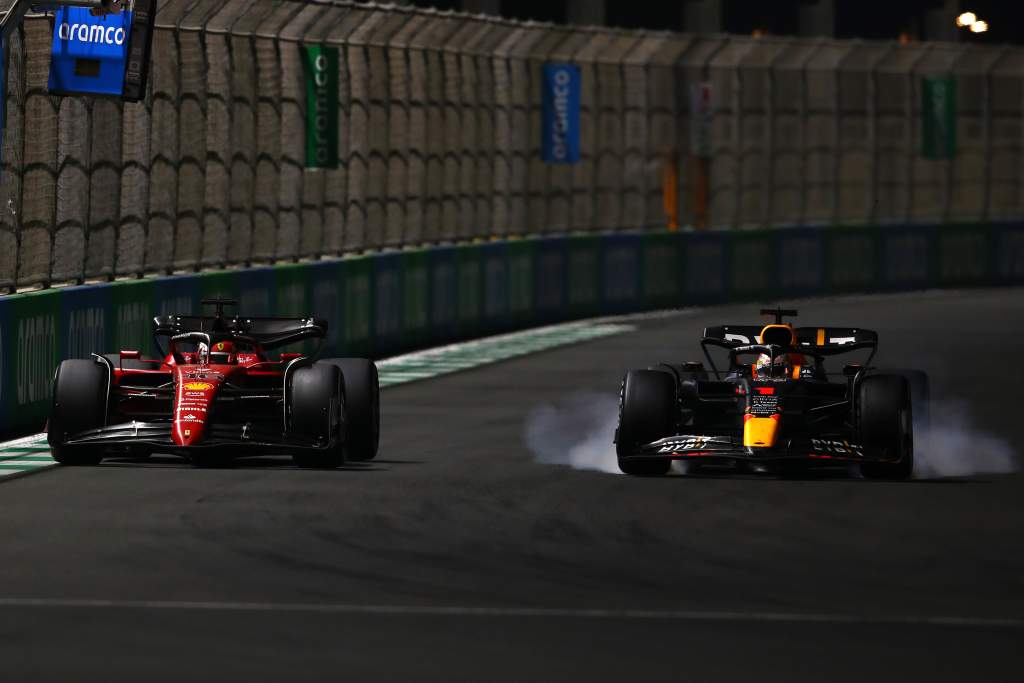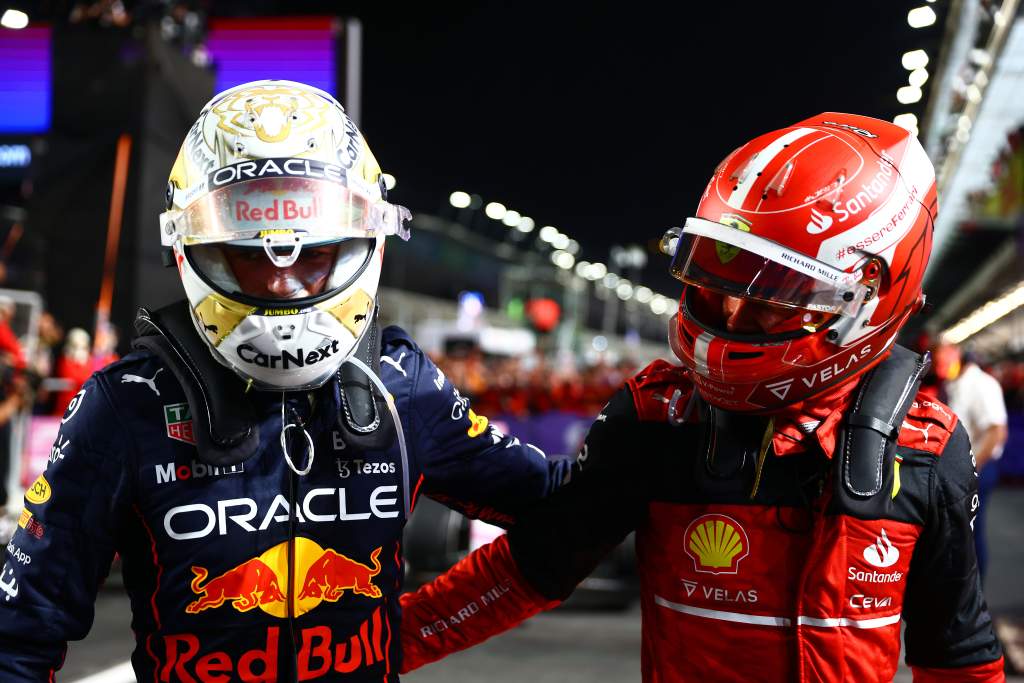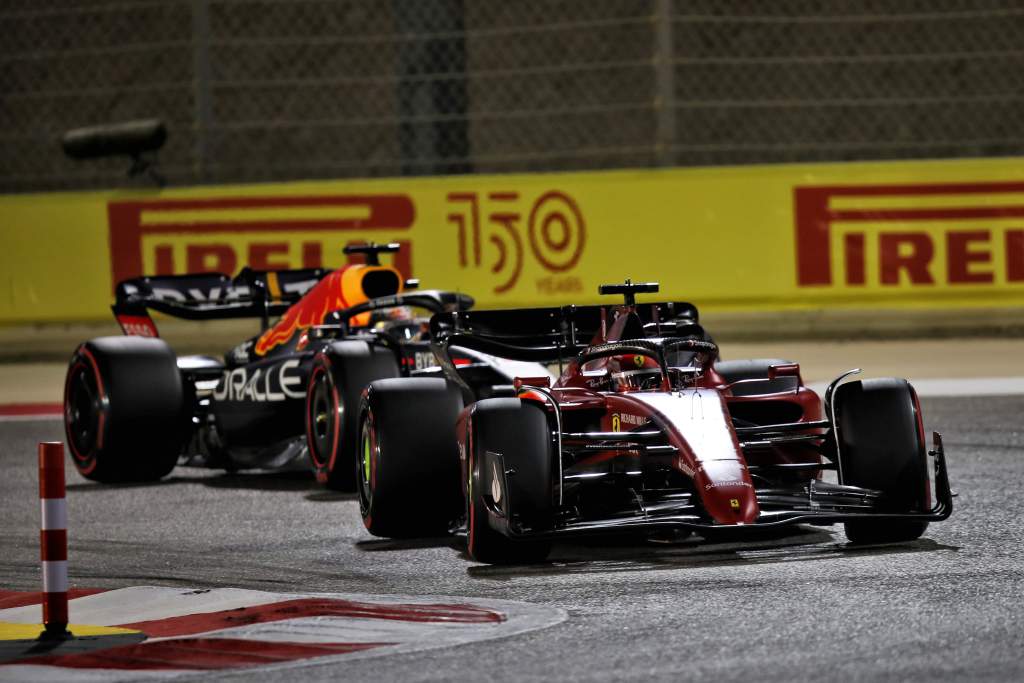Up Next

The “smart tricks” Max Verstappen and Charles Leclerc played with the DRS detection line were a vital part of show both drivers put on in the Saudi Arabian Grand Prix.
A combination of the Jeddah circuit’s layout, with three successive drag reduction system zones, and the powerful effect of activating the DRS with the big-winged 2022 cars led to a unique spectacle last weekend.
During their fight, neither Verstappen or Leclerc wanted to be ahead on the approach to the final corner, where the DRS detection line was for the start-finish straight.

At one point, both drivers slowed right down – and Verstappen even locked up – as they tried to avoid being the first across the line and thus being vulnerable to the other driver being able to use the DRS on the straight towards Turn 1.
Both drivers revelled in their battle, which Verstappen said “wasn’t easy, playing smart tricks in the last corner”, and it was undeniably entertaining.
The odd sight of seeing two drivers trying to go as slow as possible probably disguised the intelligence and quality of the fight. This battle, while unusual, certainly had its competitive merits. And for something that briefly looked quite silly, it was also cerebral.
“Charles really played it smart in the last corner,” said Verstappen. “So it was not easy for me to actually get by. And of course I had to line myself up again to have another go at it.”
Leclerc said: “I knew that the strength of Max and the Red Bull in general this weekend was the straightline speed. So, I basically knew that if I was leaving Max with the DRS for the main straight, I will basically be overtaken very easily.
“I just wanted that DRS, so on the first lap, I braked very early and I got the DRS and manage to overtake back on the run to Turn 1.
“And then the second one, obviously Max knew that I was going to do that, so we both braked quite early, but I still managed to stay in front at the end.
“And the third time, it didn’t work out for me.”

One question posed afterwards though is whether these ‘tricks’ were a fun novelty but best avoided in the future.
“The DRS is so powerful,” said Red Bull team boss Christian Horner.
“You could see there was a game of cat and mouse going on between the drivers where they’d actually brake to a point that they then accelerated to the corner.
“Maybe we should look at where that DRS detection zone is for future years because you definitely want to avoid being in that situation.”
The track layout is almost certainly the main factor here as the DRS detection line also came into play in last year’s race when Verstappen fought with title rival Lewis Hamilton.
So, the simplest change would be to move the DRS detection zone to the exit of the corner.
But the new 2022 technical regulations appeared to play a part too.

Verstappen said it was “a lot more tricky” to just overtake into the last corner this year because it’s now easier to follow, which makes an instant retaliation more likely.
“It’s a lot harder to plan your pass,” he said.
Of course, it could be said that the DRS itself might as well be scrapped if following is easier and the sort of tactics required in Saudi Arabia is not what F1 wants on a regular basis.
But removing DRS entirely would have likely meant there was no lead battle at all.
Both Verstappen and Leclerc were adamant the power of the DRS, as Horner noted, was a defining factor in the longevity of their fight.
“If I didn’t have DRS today I would have never passed,” said Verstappen.
“I think we are still too sensitive for that. And of course, some tracks are easier to pass than others.
“But if DRS wouldn’t be there, I would have been second.”
Leclerc simply said: “I think we still need DRS for now.”
So, there is clearly a sweet spot to strike. Which means fine-tuning how DRS is used.
The mix of wing levels across the grid meant some cars were finding it easy to perform drive-by passes using the DRS in Saudi Arabia, while others barely got close enough to make a move into Turn 1.
There is no one-size-fits-all approach to the position and length of a DRS zone.
But when the DRS was first introduced over a decade ago its intention was to allow drivers to get close enough to challenge into a braking zone.

Yet for years, several DRS zones have felt misjudged and the benefit of having the DRS is overpowered.
It would be wise for F1 and the FIA to take the opportunity with the new generation of cars to tinker with the detection points and the activation points to find the right balance.
While the DRS remains a necessary F1 evil, it needs to be something that gives the chasing car a helping hand without giving it a free pass.
In Saudi Arabia, the DRS contributed to some hard, smart racing that briefly strayed slightly into the realm of daftness. As a one-off, that’s not really a problem. Quite the opposite.
But as the DRS is a love-hate part of F1 already, it is probably not something that will benefit long-term if it ends up creating a perception drivers are having to play games to take advantage of an overpowered gimmick.






